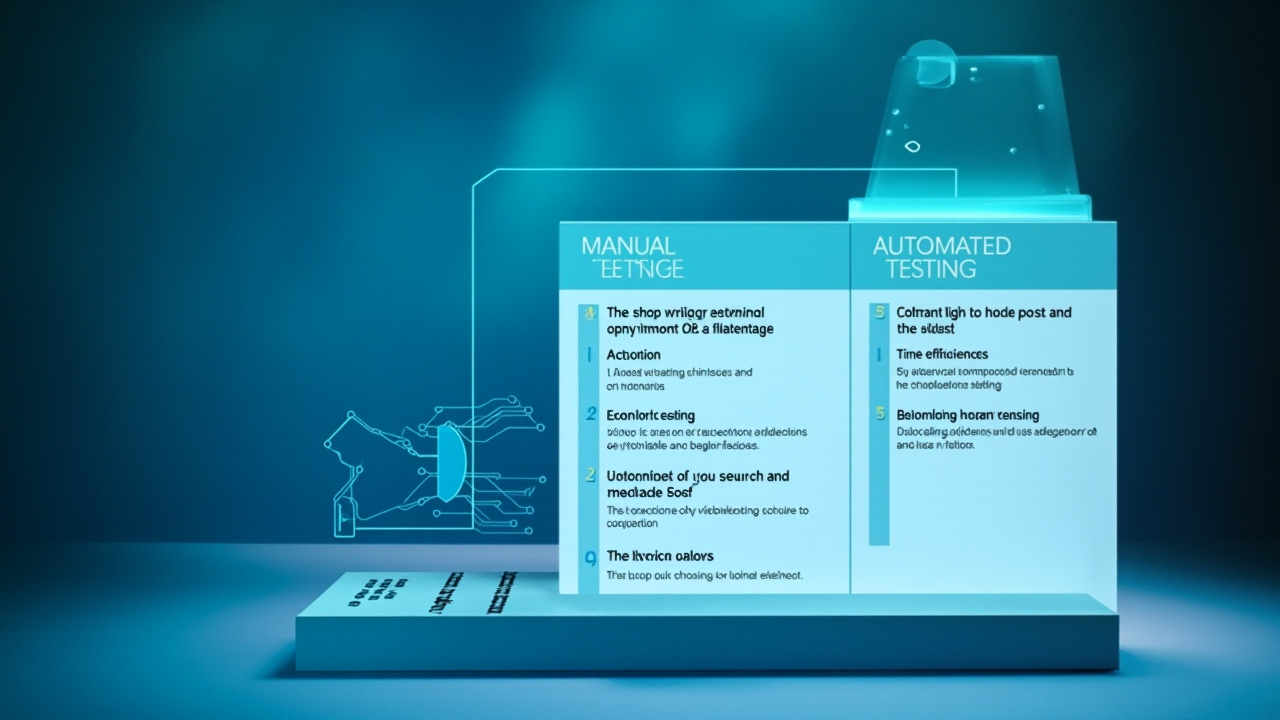The Ultimate Guide to Software Testing: Ensuring Quality and Reliability in Software Development
In the fast-paced world of software development, ensuring the quality and reliability of software products is more critical than ever. With the increasing complexity of software applications and the demand for rapid delivery, the role of software testing has become paramount. But what exactly is software testing, and why is it so vital? As we delve into this ultimate guide, we’ll uncover the nuances of software testing, explore its various methodologies, and highlight why it’s an indispensable part of the software development lifecycle.
Imagine a world where software applications run flawlessly, where bugs and glitches are things of the past. While this might seem like a distant dream, effective software testing brings us closer to that reality. Testing not only helps identify defects but also enhances the user experience by ensuring that applications meet specified requirements. In this comprehensive guide, we will navigate through the landscape of software testing, offering insights into strategies that can help you achieve excellence in software quality assurance.
Whether you’re a seasoned software developer, a quality assurance professional, or someone new to the tech industry, this guide will equip you with the knowledge to understand and implement effective software testing practices. From traditional testing methodologies to cutting-edge automated testing tools, we will cover the spectrum of testing techniques that can help you deliver robust and reliable software. By the end of this guide, you’ll have a holistic understanding of software testing and its pivotal role in the software development lifecycle.
—
Understanding the Fundamentals of Software Testing

Software testing is a crucial process in the software development lifecycle, aimed at identifying and fixing bugs before the software is released. It ensures that the software meets the required specifications and is free of defects. But what are the core principles that underlie this process?
The Definition and Purpose of Software Testing
At its core, software testing involves executing a program or application with the intent of finding software bugs. The primary purpose of testing is to ensure software quality by verifying that the software performs as expected under various conditions. It involves a meticulous examination of both functional and non-functional aspects of the software, covering everything from performance to security.
“Testing is not just about finding bugs; it’s about understanding and improving the product.”
Software testing provides an objective, independent view of the software, allowing businesses to appreciate and understand the risks of software implementation. The ultimate goal is to deliver a high-quality product that satisfies customer needs and is free from defects. This ensures a positive user experience, which is critical in today s competitive market where user satisfaction is directly linked to brand loyalty and profitability.
The Software Testing Lifecycle
The software testing lifecycle (STLC) is a sequence of specific activities conducted during the testing process to ensure quality goals are met. These stages are integral in forming a structured approach to testing, ensuring thorough and efficient validation of software capabilities. The stages include
- Requirement Analysis: Understanding what is to be tested, including both functional and non-functional requirements.
- Test Planning: Strategizing how testing will be done, including resource allocation, tool selection, and scheduling.
- Test Case Development: Writing detailed test cases that outline specific conditions and expected results.
- Environment Setup: Preparing the environment for testing, which involves configuring hardware and software conditions.
- Test Execution: Running the tests and logging the results for analysis.
- Test Cycle Closure: Evaluating the cycle completion criteria, summarizing test results, and documenting lessons learned.
These stages ensure a systematic approach to testing, allowing teams to deliver a product that meets the expectations of stakeholders. By adhering to the STLC, teams can mitigate risks, manage defects effectively, and ensure that the final product is both functional and reliable.
Types of Software Testing
There are numerous types of software testing, each serving a distinct purpose. Understanding these types is essential for selecting the right approach for your project
- Unit Testing: Testing individual components for correct functionality. This is usually performed by developers and focuses on validating each unit of the software code. Integration Testing: Ensuring that different modules work together. This type of testing is vital for identifying issues that occur when combining components. System Testing: Verifying the complete integrated system to check if the system meets the specified requirements. Acceptance Testing: Validating the system’s readiness for deployment by confirming that it meets business needs and is acceptable to end-users.
By understanding these types, teams can choose the right testing strategy tailored to their project needs, ensuring comprehensive coverage and effective defect management.
Manual vs. Automated Testing: Choosing the Right Approach

Choosing between manual and automated testing is a critical decision that can significantly impact the efficiency and effectiveness of your testing efforts. While both approaches have their strengths and weaknesses, the key lies in understanding when to use each.
The Case for Manual Testing
Manual testing involves human testers executing test cases manually without the use of automated tools. This type of testing is essential for exploratory tests, usability tests, and ad-hoc testing.
“Manual testing is indispensable when human intuition and creativity are required.”
Manual testing allows for a more nuanced understanding of the user experience and can uncover issues that automated tests might miss. For example, usability testing relies heavily on human intuition to assess how user-friendly an application is. Testers can provide immediate feedback on the look and feel of a software application, which is crucial during the early stages of development. However, manual testing can be time-consuming and less efficient for repetitive tasks, such as regression tests that need to be run frequently.
The Rise of Automated Testing
Automated testing uses specialized tools to execute tests automatically and compare actual outcomes with expected outcomes. It is particularly useful for regression testing, performance testing, and scenarios requiring repeated execution. Automation is beneficial in environments where the software undergoes regular changes and updates, as automated tests can be quickly re-run to ensure new changes do not introduce new defects.
Automated testing can significantly reduce the time required to execute repetitive test cases, allowing for faster feedback loops and more frequent releases. However, it requires an initial investment in terms of tool selection and script development. The development of robust automation scripts can be a time-intensive process, requiring skilled resources to ensure scripts are maintainable and scalable.
Balancing Manual and Automated Testing
The most effective testing strategies often involve a combination of both manual and automated testing. By leveraging the strengths of each, teams can achieve a comprehensive testing approach that maximizes efficiency and effectiveness. For example, while automated tests can handle repetitive tasks efficiently, manual testing can be reserved for scenarios requiring human judgment and creativity. This balanced approach ensures that software products are both technically sound and user-friendly.
The Role of Test Automation Frameworks

In the realm of automated testing, test automation frameworks play a pivotal role. They provide a systematic approach to automate tests and enhance the efficiency of testing processes. Understanding and implementing these frameworks can greatly improve the productivity and accuracy of testing activities.
What Are Test Automation Frameworks?
A test automation framework is a set of guidelines or best practices for creating and designing test cases. These frameworks help improve test efficiency, provide high reusability, and reduce the cost of maintenance. They act as a blueprint for building and executing test scripts, offering a structured way to organize test data and manage test results.
“A robust automation framework is the backbone of successful automated testing.”
Frameworks can be classified into various types, including module-based, data-driven, keyword-driven, and hybrid frameworks. Each type offers distinct benefits and is suited to different testing scenarios. For instance, a data-driven framework facilitates the testing of multiple data sets through parameterization, while a keyword-driven framework is built on the abstraction of test automation code using descriptive keywords.
Benefits of Using Automation Frameworks
Using a test automation framework offers several advantages
- Enhanced Test Efficiency: Frameworks streamline the test creation process, leading to faster and more efficient testing. By providing a structured approach, they reduce redundancy and simplify the execution of complex test scenarios. Improved Test Accuracy: Automated tests reduce human error, improving the accuracy of test results. With frameworks, tests can be executed consistently, ensuring reliable results across multiple test cycles. Better Resource Utilization: Frameworks enable the reuse of code, optimizing resource utilization and reducing redundancy. Test scripts can be reused across different projects, saving time and effort in script development.
Selecting the Right Framework
Choosing the right test automation framework depends on various factors, including the complexity of the application, the skills of the team, and the project requirements. It’s crucial to evaluate multiple frameworks and select one that aligns with your project goals. The right framework will support scalability, easy maintenance, and integration with other tools in the development pipeline.
Exploring Testing Methodologies and Techniques

Testing methodologies and techniques define the overall testing approach and are essential to achieving comprehensive test coverage. Understanding these methodologies is key to implementing effective testing strategies that align with project goals and timelines.
Agile Testing Methodology
Agile testing is a core component of the agile software development methodology, which emphasizes flexibility, collaboration, and customer satisfaction. Testing is integrated throughout the development process, allowing for continuous feedback and improvement. In agile testing, the focus is on delivering small, incremental releases with high quality. Testing is not a separate phase but a continuous activity, ensuring that each iteration meets the necessary quality standards.
“Agile testing ensures that testing keeps pace with development, leading to higher quality and faster releases.”
Agile testing methodologies encourage an adaptive and responsive approach to testing, where requirements and solutions evolve through collaboration between cross-functional teams. This methodology is particularly effective in environments that require rapid adaptations to changing requirements.
Waterfall Testing Methodology
In contrast, the waterfall methodology follows a linear, sequential approach. Testing occurs at the end of the development cycle, making it less flexible but suitable for projects with well-defined requirements. In waterfall testing, each phase must be completed before the next one begins, and there is typically little room for changes once a stage is completed.
Waterfall testing is advantageous in projects where requirements are well understood from the start, and changes are unlikely. It provides a structured approach with clear deliverables and milestones, making it easier to manage projects with fixed timelines and budgets.
Testing Techniques: Black Box and White Box
Testing techniques can be broadly categorized into black-box and white-box testing.
- Black Box Testing: Focuses on testing the functionality of the software without looking at the internal code structure. Testers are not concerned with how the application works internally but focus on inputs and expected outputs. This technique is suitable for validating user interfaces, workflows, and overall system behavior. White Box Testing: Involves testing the internal structures or workings of an application. Testers evaluate the code structure, logic paths, and data flow. This technique is useful for optimizing code efficiency, ensuring security, and verifying the correctness of algorithms.
Each technique provides unique insights, and often, a combination of both is used to ensure comprehensive coverage. By integrating both black-box and white-box testing methods, teams can achieve a more thorough validation of the software.
Effective Test Case Management

Test case management is a critical aspect of software testing that involves organizing and maintaining test cases to ensure effective test coverage and traceability. Proper test case management ensures that testing efforts are organized and aligned with project goals, facilitating efficient defect tracking and resolution.
The Importance of Test Cases
Test cases are the cornerstone of software testing. They define the conditions under which a test will determine whether an application is functioning correctly. A well-structured test case provides a clear and comprehensive description of the test scenario, ensuring that all aspects of the software are validated.
“Well-written test cases are the blueprint for successful software testing.”
Test cases play a crucial role in ensuring that all functional and non-functional requirements are met. They provide a basis for testing coverage, ensuring that no critical aspect of the software is overlooked. Additionally, test cases serve as a reference for future testing cycles, providing a historical record of what has been tested and any issues that were identified.
Writing Effective Test Cases
Effective test cases are clear, concise, and comprehensive. They should include
- Test Case ID: A unique identifier for each test case, facilitating easy tracking and management. Description: A brief overview of what the test case aims to verify, including the specific functionality being tested. Steps to Execute: Detailed steps to perform the test, ensuring consistency and repeatability. Expected Result: The anticipated outcome if the application is functioning correctly, providing a benchmark for evaluating test results.
Writing effective test cases requires a deep understanding of the application and the user requirements. Test cases should be written in a manner that is easy to understand and follow, ensuring that they can be executed by any member of the testing team without ambiguity.
Managing Test Cases
Test case management tools can help organize and maintain test cases, ensuring that they are easily accessible and traceable. These tools provide a centralized repository for test cases, facilitating collaboration and reporting. Test management tools also offer features such as version control, test execution tracking, and integration with defect tracking systems, enhancing the overall efficiency of the testing process.
The Future of Software Testing: Trends and Innovations

As technology evolves, so too does the field of software testing. Staying abreast of the latest trends and innovations is essential for maintaining a competitive edge. Emerging technologies are transforming how testing is conducted, making it more efficient and effective.
The Impact of AI and Machine Learning
Artificial intelligence and machine learning are revolutionizing software testing by enabling smarter, more efficient testing processes. AI-driven tools can automatically generate test cases, predict test outcomes, and identify potential defects. With AI, testing can be more predictive, allowing teams to focus on areas with higher defect probabilities.
“AI is transforming software testing from a reactive process to a proactive one.”
Machine learning algorithms can analyze historical test data to identify patterns and trends, providing insights into potential risk areas. These insights enable teams to proactively address issues before they impact users, enhancing the overall quality of the software.
The Rise of Continuous Testing
Continuous testing is an emerging trend that integrates testing into the continuous integration/continuous deployment (CI/CD) pipeline. This approach ensures that testing is performed throughout the software development lifecycle, providing rapid feedback and reducing time to market. Continuous testing allows for frequent releases without compromising on quality, making it an essential practice in today’s agile and DevOps environments.
Test Automation Advancements
Advancements in test automation, such as scriptless test automation and self-healing test scripts, are making it easier for teams to implement and maintain automated tests. These innovations reduce the technical barriers to automation, allowing more teams to leverage its benefits. Scriptless automation tools enable testers to create automated tests without writing code, while self-healing scripts automatically adjust to changes in the application, reducing maintenance efforts.
In conclusion, software testing is an essential component of software development, ensuring that applications are reliable, functional, and meet user expectations. By understanding the various testing methodologies, techniques, and tools available, teams can implement effective testing strategies that enhance software quality and accelerate delivery. As the field of software testing continues to evolve, embracing new trends and innovations will be key to staying ahead in the competitive world of software development.
As you continue your journey in software testing, remember that the ultimate goal is not just to find bugs, but to deliver high-quality software that delights users. Whether you are a developer, tester, or project manager, your role in the testing process is critical to the success of the software. So, dive deeper, explore further, and keep testing!
Explore More on This Topic
Interested in diving deeper into this subject? Connect with experts or explore additional resources to expand your understanding.
If the link above does not work, please visit: https://calendly.com/dm-csimplifyit/30min?month=2025-05